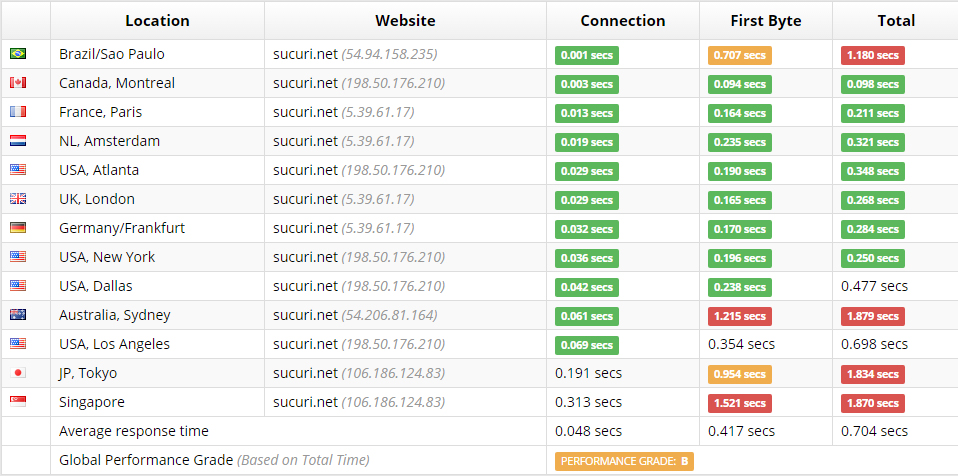Sucuri launched a new free performance tool today. The Global Website Performance Tester allows anyone to enter a URL and get a quick assessment of how fast the website is loading from 13 globally distributed testing stations. Results include three key metrics: connection time, time to first byte (TTFB) and total load time.
At the moment, there are no plans for an API, but Sucuri CEO Tony Perez said that it’s possible to build one if there’s enough demand.
The new performance checker is a simple free tool that the Sucuri team built for its own use but also signifies the company’s foray into performance-related products and services.
“Performance can easily fall into the realm of Availability, and as such we see it as an important piece of security,” Perez told the Tavern. “There is no denying that performance is top of mind to most website owners, as is security.”
Sucuri has been quietly beefing up its architecture to support an expansion into performance-related services that would go hand-in-hand with its WAF (Website Firewall) product.
“We’ve been building out our network and performance is a tenant of our Website Firewall,” Perez said. “It was imperative that we understood how good or bad our network was compared to the other performance (CDN) providers. Like most things we do, the performance tool was a tool to satisfy our own needs.”
Sucuri Is Expanding to Accommodate Plans for a Full-Featured CloudFlare Alternative
Sucuri is currently managing over 40 billion page views per month via its WAF network. The team is working on expanding to a full WAF/CDN solution to serve performance-related features.
“The fundamental difference is that it’s security first, performance second,” Perez said. “So yes, in the coming months you’ll see more as our solution blossoms into a full WAF/CDN solution.”
Up until now the company has been limited by using a leased architecture but is making changes to support the WAF/CDN expansion.
“We’re actively migrating from a leased architecture to our own infrastructure, giving us full control of the website,” Perez said. “This gives us optimal control to mitigate all attacks, including large scale DDOS attacks; a by-product of that will be performance in the form of a global CDN.”
Sucuri is is building its own DNS architecture with full DNS management within its application.
“Users will have an alternative to solutions like CloudFlare,” Perez said. “The fundamental difference being we’re a security company first.
Sucuri is building its expansion on top of the an Anycast network, which means that users’ requests will be routed to the nearest node on request.
“With most of the content cached at the edge it’ll be designed for optimal speeds regardless of where you are in the world,” Perez said. “That’s perhaps the biggest feature – most everything comes down to our design and configuration and how we handle the traffic.”
When asked if he sees the final WAF/CDN solution to be a comprehensive Cloudflare alternative, Perez responded, “Oh hell yeah – with one key differentiator: we’ll clean the mess too.”
“The idea is when you think of Sucuri it’s a complete package – Protection – Detection – Response. It’s all built in-house, no third-party integrations,” he said.
“The cleaning is the one thing that no one else can match us on, it’s either too much liability or they haven’t figured out how to scale.”
Sucuri’s WAF service is currently used by iThemes, Gravity Forms, List25, and many others in the WordPress space. If the company is able to deliver on their CloudFlare alternative, which is planned for this summer, customers will have the opportunity to get their security services bundled in with the new performance-enhancing features of the CDN.

Wow this is definitely some interesting news. I’m pretty excited to see what everything looks like as well as how it all works.